Knowledge Management in Enterprise Architecture
Info: 7773 words (31 pages) Dissertation
Published: 10th Dec 2019
Tagged: Management
Abstract
Now days, digital transformation plays a vital role in the way of working, living, collaboration and communication. As said by Wu, X and Zhu, X., et.al. (2014), enterprise Architecture serves as sematic-based decision support, knowledge based system and big data management etc. In order to provide adequate decision support for large and complex business or IT environment, an organisation should be transparent over affected landscape of architectural capabilities like processes, platform, applications and infrastructure.
Knowledge management helps enterprise architecture to analysis its applications for better decision making process and ability to adopt new or existing changes by eliminating legacy applications and better utilization of organisation assets.
This dissertation focuses on how knowledge management is a discipline of enterprise architecture and how we organise IT resources and gain visibility. In order to exhibit best practise of knowledge management in enterprise architecture, this research analyse tools that can be used to design enterprise architecture model for knowledge management systems.
This research was driven how digital transformation has been a vital challenge in enterprise architecture where it becomes difficult to create a transparency between business and IT hence Enterprise architecture is integrated with KMS. This research uses a lean and collaborate approach based on digital transformation. A principal approach of digital transformation is to make knowledge distributed which is available to everybody in organisation and this will help enterprise architects to make right decisions.
In literature review, identify and analyse KM tools that has optimal and efficient knowledge of enterprise architecture processes, applications and platform etc. This analysis empowers digital transformation of enterprise architecture management and provides sufficient knowledge management capabilities, which best suits for organisation in current situation.
Enterprise transformation is a vital change of an organization. These changes typically affect various stakeholders like business and program managers who have major diversity in relation to their employee’s knowledge, objective and few assumptions. However, as mentioned by Nightingale, D.J. and Mize, J.H., (2002) maintaining common understanding among stakeholders in enterprise transformation is a success.
As an informative and consulting approach, we analyse and use enterprise architecture management tool called LEAN IX and TOGAF as a framework. The result shows how LEAN IX helps an organization to become digital in building IT Architecture that helps senior management and architect to decided following:
- How data is ease to focus on
- Usability of data
- Governance
- Automation
Contents
1.2. Research Problem and Objectives:
Chapter 2 & 3: Literature Review
2.3 Components of Knowledge Management
2.4 Processes of Knowledge Management
3.2 Enterprise Architecture Frameworks:
3.2.3 Application Architecture
3.3 Types of Enterprise Architecture Frameworks
Chapter 4: Digitalization in Enterprise Architecture
Chapter 4: Knowledge Management Tools
Chapter 5: Analyse EA Framework with KM Processes
Chapter 1: Introduction
This Dissertation focuses on collaborative knowledge sharing in enterprise architecture management and empowers digital excellence. This research is conducted by applying theoretical and qualitative analyses in order to understand better concept of digital transformation in enterprise architecture with knowledge management perspective. Predominately, this research aim is to understand what tools can be applied to gain and share knowledge at enterprise level in support of digital transformation. It is said digital transformation is an intense change of business, organization activities, process and capabilities by Westerman, G. and Bonnet, et.al. (2014). In order to increase its opportunities for digital technologies, digitalization has accelerated across various large, medium and Complex IT organisations.
In this research, practically two different tools has been analysed using theoretical frameworks that are designed based on the literature review on Knowledge Management in enterprise architecture in support of digital transformation.
1.1. Research Background:
New Technology models based on communicating information has been rapidly grown in current era. As cited by Badii, A and Sharif, A., (2003), innovation in information and communication technologies has started a structural process of transformation of information and knowledge at enterprise architecture level. However, in spite of rapid changes in new technologies, knowledge sharing model has not made any changes at enterprise architecture level due to which knowledge technologies has resulted in obsolescence as mentioned by Malhotra, Y., (2005).
However, enterprise architecture is revamping its technology and organisation to focuses on changing needs of customer at a strategic level. Challenges they face are very complex and complicated as said by Nurcan, S. and Barrios, J., (2003)
It is said that at enterprise architecture level, knowledge management is used as a Decision Support System (DSS) that helps develop and effective decision making (Zhao, X., Hwang, B.G. and Low, S.P., 2016) Knowledge Management activities like Enterprise Architecture Management (EAM) add value to DSS in developing or improving architectural decision making.
Enterprise is not an activity of offering products and services but they are been used as products. It provides the grip due to changes in environment they need to change their business strategies and objective of enterprise which needs to analysed, specify required changes, structure and detail design and carry out implementation.
In order to get a grip Enterprise Architecture captures requirements for business, IT and growth of organisation. Architecture gives flexibility and adaptability to its business or organisation. Enterprise architecture provides a holistic view (Bernard, S.A., 2012)
1.2. Research Problem and Objectives:
The main objective of this dissertation is to analyse how knowledge management can be used as a tool to improve Digital Transformation in Enterprise Architecture. The research focuses on three concepts, Knowledge management, Enterprise Architecture and Digital Transformation of Enterprise Architecture using Knowledge Management Processes.
This dissertation focuses on which knowledge management tool can be best practised and makes effective use of decision support system at enterprise architecture management.
- Define requirements of knowledge management in Enterprise Architecture.
- Analyse data model
As mentioned above, we will identify and analyse which knowledge management tools, would best suit for enterprise architecture.
The main objective of this research to answer the following research questions:
- Which Knowledge Management systems best suits Enterprise Architecture?
- How Knowledge Management supports Digital Transformation Enterprise Architecture?
- What parameters to be considered when implementing enterprise architecture management in a knowledge management perspective?
- How Knowledge Management interfaces with enterprise Architecture?
1.3. Research Structure
This research consists of 5 Parts as show below:
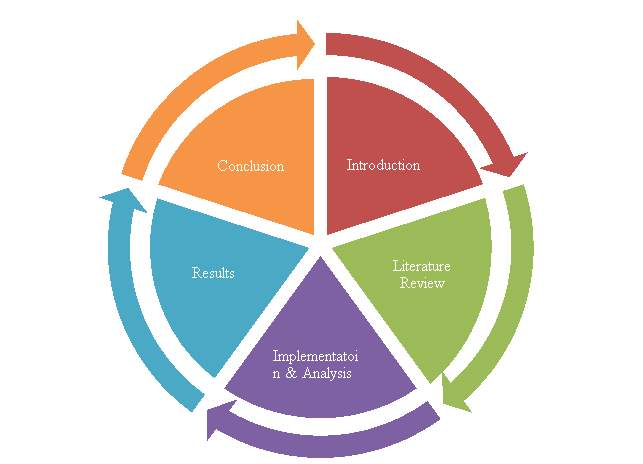
Figure 1: Structure of Research
Chapter 2 & 3: Literature Review
2.1 Knowledge Management:
Knowledge Management is an effective asset for enterprise architecture that empowers teams to take appropriate and quick decision that improves its competitive benefits. Data, information, and knowledge are essentials for every day to day activity in an organisation (Davenport, T.H. and Prusak, L., 1998). Knowledge Management is a practice that enables individuals, groups, team or organizations to systematically create, gather, share and apply knowledge. In order to achieve objectives and improves decision making process. At enterprise level, knowledge is considered as competitive in current market environment. In Current era, success is evaluated from what it is rather what it means. At an enterprise level, Knowledge is considered as a strong strategy, where knowledge does exists, implementing process across enterprise functions to ensure that these processes are accepted and supported at organisational level.
Knowledge Management is a system that makes right knowledge available to right people at right place (Christopher, D. and Tanwar, A., 2012). An organisation can learn, retrieve and practise its knowledge assets when required. As said by Adams, et.al, (2013) Knowledge management is coordination and utilize of organisational knowledge to create value and meet organizational goals.
Knowledge management generates and maintains value on its business competencies. As said by Patil and Kant et.al, (2014) “Knowledge contributes value to organisation with its products, process and people. Whilst Knowledge Management transforms information, data and assets which increases value for management to action. It also increases accessibility and availability of knowledge at right person in right place.”
As argued by Lou et.al, (2016) knowledge is only capable resource that offers competitive advantage that provides continuous growth for its partners. As mentioned by Ramanathan et.al, (2014) effective use of Knowledge Management processes is an important aspect that helps to plan and forecast future plans or operational decisions.
“KM can be viewed in many ways. One of them is the ‘process perspective’. Based on this perspective, KM focuses on understanding how knowledge is created, validated, presented, distributed, and applied within an organization (Alavi & Leidner, 2001).”
Samuel et.al, (2011), in this research paper states that conceptual model which is developed consists of knowledge process like knowledge creation, knowledge capture, knowledge organization, knowledge storage, knowledge dissemination, and knowledge application. The results with this model have indicated that among 6 knowledge management process knowledge application, knowledge dissemination and knowledge capture has played an important role because they had higher factors.
As Knowledge is applied, understood at different higher levels and data is converted from explicit into tacit and become more valuable to organization.
2.2 Types of Knowledge:
Knowledge has different forms and it is essential to distinguish different types of knowledge when implementing knowledge management. When considering digital era, knowledge is captured in a digital form that can be stored, retrieved, shared and managed for further sharing among individuals. (McAuley, A., and Stewart., et.al. 2010)
It is determined that there are 2 types of knowledge i.e. Tacit Knowledge and Explicit Knowledge.
2.2.1 Tacit Knowledge:
Tacit Knowledge is the knowledge that is stored inside an individual’s mind. As stated by Prasarnphanich, and Patel et.al. (2016) refers to Intuitive and difficult to define knowledge that is based on experience. In nature, tacit knowledge is a situation dependent and personal when comes to individual mind. As stated by Nonaka, (1994), it is difficult to communicate and intensely rooted in commitment and action when involved.
Leonard, D.A & Sensiper, states that tacit knowledge is considered as subjective and experimental knowledge that cannot be communicated. Tacit knowledge is considered as a most valued source of knowledge and likely to lead and develop and effective knowledge management under leadership role as argued by Donate, M.J. and de Pablo, J.D.S (2015). Authors like Delgado-Verde et.al 2011, also argue that lacks of knowledge cannot focus on innovative capability and competitiveness.
2.2.2 Explicit Knowledge:
Explicit knowledge is a codified and formalized knowledge which is maintained in a document, database etc. which can be stored and transferred (Nonaka, I. and Von Krogh, G., 2009). It is also called as Digital Knowledge. Research is based on this concept. However it is also mentioned that explicit knowledge is considered as rational knowledge and a theoretical approach that also helps in problem solving by Hélie, S. and Sun, R., (2010). This type of knowledge is very easy to maintain by KMS that helps in sharing, storing and managing data and information. From an enterprise architecture perspective, it’s a challenge as similar information is stored in different places or location with different people. It should also be ensured that people have right access to knowledge so that they can review and update is accordingly.
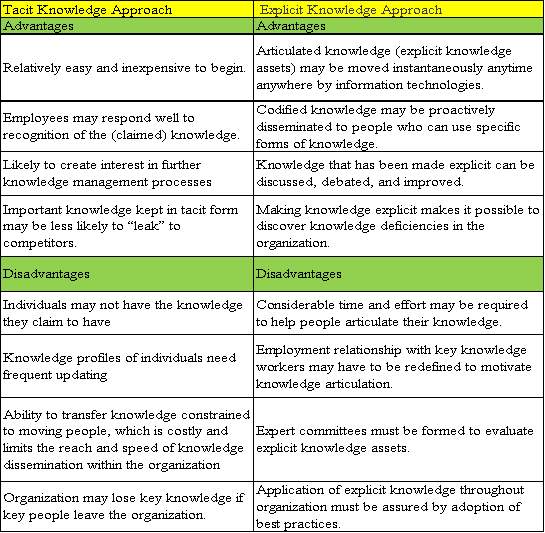
Table 1: Advantages and Disadvantages of Tacit and Explicit Knowledge Management.
As mentioned by Wellman et.al, (2009), sometimes, disagreement occurs with the creation of new knowledge as its limits the scope of Knowledge Management to programs and its techniques that employs follow. He also argues that creating knowledge is often observed as single practice and which generally comes under innovation. KM is a practice that enables individuals, teams and organisations too comprehensively and methodically creates, gather, share and apply knowledge, in order to enhance and achieve their objectives that improve its practices and acquire what has been done, stated by Abubakar, et.al, 2017,
2.3 Components of Knowledge Management
In knowledge Management System, data is gathered, captured and analysed, stored and processed into useful information (Becerra-Fernandez, I. and Sabherwal, R., 2014). In order to effectively link knowledge there are 3 critical components that are used in knowledge management system that are shown below:
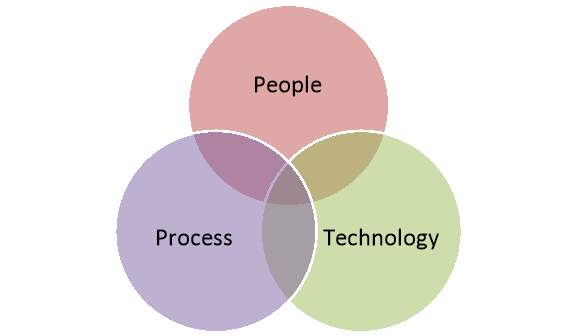
Figure 2: Components of KM
2.3.1 People:
People are considered as an advantageous asset as they create, relate and share knowledge in a tacit form. Tacit knowledge and practice are the ultimate assets of an organization that can influence innovation and capability to enhance to improve standards of sharing knowledge ( Seidler-de Alwis, R. and Hartmann, E., 2008) Managers and Consultants can become knowledge contributors and share their experience. People gain knowledge by sharing, team work, motivation, communities etc. When knowledge is capturef by people it can be reused when required.
2.3.2. Process:
In order to have effective knowledge management systems, there should be clear and brief steps where an individual can absorb and use knowledge either virtually or non-virtually (Zack, M., McKeen, J. and Singh, S., 2009). This allows business to practice and cost are reduced while implantation similar systems where knowledge is reused. Process is design in a way that it is easy absorbed and understandable. KM Processes can consist of maps, Practices, standards, workflows, Methodology, Lessons learned, reporting, roadmaps, Dashboard etc.
2.3.3. Technology:
Data or knowledge is stored in a form where it can be viewed and read. Technology allows users to communicate, collaborate, store and retrieve information. It is an essential platform that helps other components of knowledge management system (Liaw, S.S., Chen, G.D. and Huang, H.M., 2008). It acts like an enabler. Technology is used in various ways like blogs, search engines, intranet, internet, e-learning etc.
2.4 Processes of Knowledge Management
Knowledge Management process is a strategy used to acquire and benefit from knowledge sources and capabilities (Zheng, W., and Yang, B. et.al. 2010). Process should be ease to capture and use the capabilities for gaining organizational benefits. When knowledge is captured it should also be organized, store or modify. Below picture shows process of knowledge Management.
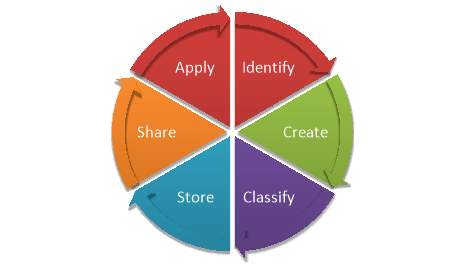
2.4.1 Identifying Knowledge:
Critical knowledge of an individual or a skill needs to be identified which helps in building core capabilities of an organisation. Knowledge is identified from experienced employees. (Chan, I. and Chao, C.K., 2008)
2.4.2 Create Knowledge:
Create new knowledge or addressing existing gaps in knowledge at individual, team or organization level (Ajith Kumar, J. and Ganesh, L.S., 2009)
2.4.1 Classify Knowledge
When knowledge is identified it needs to be classified under different levels which helps in sharing and can be easily stored at required locations. (Supyuenyong, V., Islam, N. and Kulkarni, U., 2009)
2.4.1 Store Knowledge:
Technology or system is used to store knowledge and can be reused when required. Knowledge should be given access to modify and add information (Farenhorst, R., and Izaks, R., et.al, 2008)
2.4.1 Share Knowledge:
Exchange of knowledge is required at all levels of organisation (Seidler-de Alwis, R. and Hartmann, E., 2008)
2.4.1 Apply Knowledge:
Once this knowledge is organized transform this knowledge into action that add values to product and services.
However, knowledge plays an importance role in an organisation and employee should know how to play it specifically in business process as process will be executed effectively and efficiently when an employee knows it.
3.1 Enterprise Architecture:
Enterprise architecture acts as a blueprint, which outlines the structure and operation of an organization. It determines how an organization can effectively achieve its present and future objectives as stated by Henk et.al, 2006.
According to Marc Lankhorst (2013), “A coherent whole of principles, methods and models that are used in design and realisation of an enterprise’s organisational structure, business processes, information systems and infrastructure”.
Enterprise architecture has proven to be value for demonstrating and organizing enterprise information, organisation has also standardized knowledge management usage to monitor and plan this information (Bernus, P., and Nemes, L. et.al. 2012). In this research we will be developing a system oriented model in an enterprise architectural approach. Such model would support knowledge management that enable organisation to take fast and data driven decisions.
However, it is mentioned by Schekkerman, J (2004) that enterprise architecture is a model that represents as-is and to-be architecture of an organizations. Enterprise architecture as a framework provides:
- Metal models for Enterprise Architecture
- Design and evolution methods of enterprise architecture
- Reference models or blueprints as stated above
3.2 Enterprise Architecture Frameworks:
Enterprise architecture framework (EA Framework) explains how to create and design enterprise architecture (Taleb, M. and Cherkaoui, O., 2012). Enterprise architecture framework defines a process for information systems that sets a building block and how they can be managed together. It is mentioned that enterprise architectural structure is divided into domains, layers and models by Engelsman, W., and Quartel, D., Jonkers et.al 2011. This structure helps in making design decisions for all the components of the systems that also helps in enhancing new design requirements that sustains and provides support.
As mentioned by Da Xu, L., 2011 below are 4 domains of enterprise architecture:
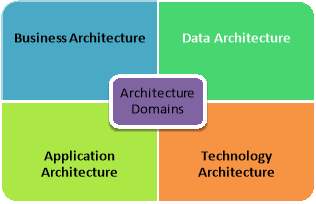
Figure 3 Architecture Domains
3.2.1 Business Architecture
Business Architecture is said as an enterprise blueprint that delivers aims and support objectives and capabilities of organization. Business architects maintain and develop this domain. It is a link between business model and strategy which is also supported by Whittle, R. and Myrick, C.B et.al (2016).
3.2.2 Data Architecture
Data architecture manages enterprise knowledge based what data is collected, how it is been stored, organized, where it is been incorporated and how data is used in organisation system also said by Inmon and Zachman et.al, (1997)
3.2.3 Application Architecture
Application architecture defines the performance of an application that is used, its integration capabilities. It describes how data flows between applications. And they are mapped to business functions which are also agreed by Ruh and Maginnis et.al, (2002).
3.2.4 Technology Architecture
Technology Architecture defines organizational computing, telecommunications and networks. Winter, R. and Fischer, R., (2006) has also mentioned same.
3.3 Types of Enterprise Architecture Frameworks
Yet to write
- The Open Group Architecture Framework (TOGAF)
- Gartner EA Framework
- The Zachman Framework for Enterprise Architectures
Chapter 4: Digitalization in Enterprise Architecture
Digital transformation is buzzword for organizations nowadays and enterprise is changing its technology and organization aims that are changing as per customer needs (Westerman, G., and Bonnet, D et.al, 2014) Challenges are quite complex and multidimensional in nature. This seems to be right opportunity for enterprise architecture to change the organization goals. Enterprise architecture explains process, technology, information and organizational elements that design enterprise architecture to implement effective approach and manage them accordingly.
However, as mentioned in whitepaper (Transforming Enterprise Architecture for Digital Empowerment By Jason Bloomberg – EA Thought Leader) existing enterprise architecture may not focus on comprehensive improvements on business as they mostly focus on technology. Enterprise architect should align with digital transformation initiatives for better scope and significance in transformation.
To manage enterprise architecture in organization there are 5 maturity levels:
- Level 0: Clean up mess
At this level, enterprise architecture focuses on IT Portfolio management by understanding what applications are in place, where is it integrated; stakeholder’s information etc. by gaining visibility on IT resources that address may issues.
- Level 1: Managing through Excel
Excel spreadsheet provides limited scope for IT Portfolio management, as typically is used a central repository of organization. As it’s influential but doesn’t collaborate with enterprise architecture capabilities.
- Level 2: Tool in place
With the present trend of cloud technology and digital transformation, traditional tools that are already integrated in enterprise architecture might have various capabilities that are not flexible for digital initiatives as they have to thrive for agile priorities. At this level, EA can rationalize license, IT Portfolio and patch management that integrates by assessing and mapping technology and applications.
- Level 3: Transition from traditional to digital
A traditional tool doesn’t support agility that is required for digital transformation.
- Level 4: Agile in enterprise architecture
Digital transformation requires changes in cross organization to ease self- organizing teams. Organization that are using EA tools will support goals in real time business and IT integration as there will be a self-service visibility in digital assets. Achieving digital transformation in long term needs to rethink of how enterprise can be build, who manages it and how is it supported.
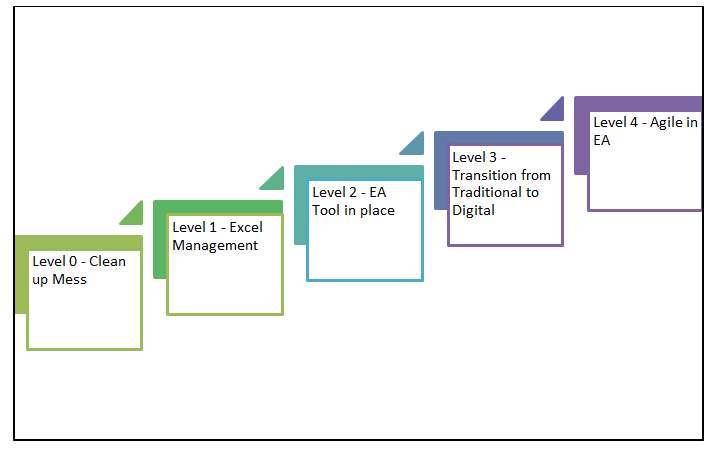
Figure 4 Stages of Digital Transformation in EA
As mentioned in white paper, few approaches that can initiate digital transformation
- Integration and API’s:
Need to understand how we can leverage and integrate existing assets that are based on software.
- Cloud and systems Architecture
Ensure how digital technology is scalable, modern and secure irrespective to the nature of the application like hybrid etc.
- Data Management
Driving and processing customer data and controlling existing data into digital transformation. Enterprise architect plays a vital role to help data management team and digital team to work together
- Business processes
Change management team acts as an enabler while digital transformation but traditional approach of change management will not support the needs of transformation. Enterprise architect has to facilitate a synchronized approach that helps change management team to raise a level that requires transformation especially from business as IT.
- Maintain Strategic Vision:
Enterprise architect should maintain and emphasis on overall business strategy and connects with team on day to day responsibilities as there are many challenges during transformation.
Chapter 4: Knowledge Management Tools
Knowledge Management tools are the tools that help organisation to use and share information in internal and external ways of communication or operations (Heisig, P., 2009). Knowledge is stored in different ways. Knowledge consists of technical information, product information, application information or procurement information. Knowledge can be of any form and stored in various ways like using blogs, social networks, portals, communities etc. and it’s a searchable content (Dave, B. and Koskela, L., 2009).
In a way knowledge management is all about capturing, creating and sharing information whereas at an enterprise level, knowledge is define to make strategies, define process, and share technical information in organizational prospective. In enterprise architecture we use knowledge management for decision support system (Wen, W., and Chen, 2008.) That captures all inventory information of business like application, process, vendor and technology. Knowledge management is all also managing people, culture and practices that exist in organisation. In enterprise architecture to gain more visibility on business value and critically we transform knowledge management in a digitalized approach that adds value to the information.
We have identified few knowledge management tools as mentioned below for enterprise architecture:
- Enterprise Portal:
As mentioned by Cloete, M. and Snyman, R (2003), enterprise portal is also considered as a knowledge management tool. It is said that enterprise portal focuses on application as Knowledge management tool. Little attention, towards other aspects of KM. In in this article it provides strategic and tactical relationship of enterprise portal and knowledge management.
According to Shilakes and Tylman (1998) of Merrill Lynch’s Enterprise software Team:
“Enterprise Portals are applications that enable companies to unlock internally and externally stored information, and provide users a single gateway to personalised information needed to make informed business decisions”
Enterprise Portal is a portal that that captures organizes, distributes and interaction of knowledge among organization. Enterprise Portal is usually a web-based access portal that has enterprise information, application information and process that are defined. The main task for enterprise portal is to encapsulate all these information and provide as an interface that has easy access which saves cost and time for organization. As this information is been manage centrally distribution of data becomes efficient. This reduces time in searching, duplicating and usage of out dated information.
- SharePoint:
SharePoint is a web based tool that facilitates process of knowledge management activities that improves performance and operations. It is a content management and collaboration tool that is used as medium to share information in an organization. It’s simple and adaptive in nature. It is a kind of enterprise repository where you store the document and provide access to upload and download documents. It is said by Liu, S. and Li, J., 2015, that major gap with SharePoint is you cannot link processes or cannot find an answer for a question.
- Signavio
It is a business process model platform that allows user to create, design and enhance business processes. Information that is captures link to different process and explains how it work and where a decision can be taken and present it in a collaboration hub. With this kind of process transparency in process and decision will impact in decision making with a positive approach. It is reliable and best business process model as it provide business decision capability for organization. It integration with third party is simple and built in with REST APIs. (Mendling, J and Recker, J.C et.al, 2012)
- Lean IX:
As mentioned by BDNA, (2016), Lean IX offers innovative solution based on SaaS for enterprise architecture management on public cloud. This web based platform has captivating advantageous over traditional knowledge management approaches that includes flexible reporting, ease to use interface and open API’s. I need minimal training that adds value to organization. It maintains technopedia that has current, complete, reliable repository that consists of up to date hardware and software information. Lean IX is used as a transformation of knowledge into digitalization which is diverse is and cross functional. As mentioned by Conway’s Law “Organisational structure likely to follow technological devices. By maximising cross-functional technology organization can implement DevOps and other collaborative activities for digital transformation.
As mentioned n white paper, Lean IX creates a workspace for organizations which captures and stores information, application name, vendor, markets or uses groups, business capabilities, records business value of the application and also provides technical details of the application. Lean IX helps implements tags to business capabilities like high, low. It links application and business capability which creates a transit between business and technology architectures. It also provides easy visualization of business. It analyses and creates out of box reports. It provides best analyses when a decision needs to be made by business.

Figure 5: Features of Various Knowledge Management Tools
Chapter 5: Analysis and Methodology
5.1 Analysis of Tools:
Yet to write
Chapter 6: Results
Yet to write more
Chapter 7: Conclusion
Yet to write
Chapter 8: References
- Abell A and Oxbrow N (1999) Skills for Knowledge Management. TFPL Ltd, London.
- Abubakar, A.M., Elrehail, H., Alatailat, M.A. and Elçi, A., 2017. Knowledge management, decision-making style and organizational performance. Journal of Innovation & Knowledge.
- Adams, G.L. and Lamont, B.T., 2003. Knowledge management systems and developing sustainable competitive advantage. Journal of knowledge management, 7(2), pp.142-154.
- Ajith Kumar, J. and Ganesh, L.S., 2009. Research on knowledge transfer in organizations: a morphology. Journal of knowledge management, 13(4), pp.161-174.
- Alavi, M. and Leidner, D. E., 2001. Review: Knowledge management and knowledge management systems: Conceptual foundations and research issues. MIS quarterly, pp.107-136
- Bernard, S.A., 2012. An introduction to enterprise architecture. AuthorHouse.
- Badii, A. and Sharif, A., 2003. Information management and knowledge integration for enterprise innovation. Logistics Information Management, 16(2), pp.145-155.
- Bernus, P., Nemes, L. and Schmidt, G.J. eds., 2012. Handbook on enterprise architecture. Springer Science & Business Media.
- Becerra-Fernandez, I. and Sabherwal, R., 2014. Knowledge management: Systems and processes. Routledge.
- Burstein FV, Zyngier SM, McCullough G, Oliver G, Symonds J and Brown M (2003) Leading knowledge management strategies in Australia and New Zealand: a comparative study of public and private sector organisations. In Proceedings 14th Australasian Conference on Information Systems (Lethbridge N Ed) pp 1-10, Edith Cowan University, Perth WA, Australia.
- BDNA Announces New Partnership With LeanIX 2016, , New York.
- Business Capabilities: How to win the digital age with a common language for Business & IT White Paper
- Cloete, M. and Snyman, R., 2003, October. The enterprise portal–is it knowledge management?. In Aslib Proceedings(Vol. 55, No. 4, pp. 234-242). MCB UP Ltd.
- Christopher, D. and Tanwar, A., 2012. Knowledge management in outsourcing environment: people empowering people. IUP Journal of Knowledge Management, 10(2), p.61.
- Chan, I. and Chao, C.K., 2008. Knowledge management in small and medium-sized enterprises. Communications of the ACM, 51(4), pp.83-88.
- Dave, B. and Koskela, L., 2009. Collaborative knowledge management—A construction case study. Automation in construction, 18(7), pp.894-902.
- De Tienne KB, Dyer G, Hoopes C and Harris S (2004) Toward a model of effective knowledge management and directions for future research: culture, leadership and CKO’s. Journal of Leadership and Organizational Studies 10 (4), 26-43
- Donate, M.J. and de Pablo, J.D.S., 2015. The role of knowledge-oriented leadership in knowledge management practices and innovation. Journal of Business Research, 68(2), pp.360-370.
- Delgado-Verde, M., Martín-de Castro, G. and Emilio Navas-López, J., 2011. Organizational knowledge assets and innovation capability: evidence from Spanish manufacturing firms. Journal of intellectual capital, 12(1), pp.5-19.
- Davenport, T.H. and Prusak, L., 1998. Working knowledge: How organizations manage what they know. Harvard Business Press.
- Da Xu, L., 2011. Enterprise systems: state-of-the-art and future trends. IEEE Transactions on Industrial Informatics, 7(4), pp.630-640.
- Enterprise architecture at work: modelling, communication and analysis by Lankhorst, Marc. The enterprise engineering series, 2013, 3rd ed
- Engelsman, W., Quartel, D., Jonkers, H. and van Sinderen, M., 2011. Extending enterprise architecture modelling with business goals and requirements. Enterprise Information Systems, 5(1), pp.9-36.
- Farenhorst, R., Izaks, R., Lago, P. and Van Vliet, H., 2008, February. A just-in-time architectural knowledge sharing portal. In Software Architecture, 2008. WICSA 2008. Seventh Working IEEE/IFIP Conference on (pp. 125-134). IEEE.
- Hélie, S. and Sun, R., 2010. Incubation, insight, and creative problem solving: a unified theory and a connectionist model. Psychological review, 117(3), p.994.
- Heisig, P., 2009. Harmonisation of knowledge management–comparing 160 KM frameworks around the globe. Journal of knowledge management, 13(4), pp.4-31.
- Inmon, W.H., Zachman, J.A. and Geiger, J.G., 1997. Data stores, data warehousing and the Zachman framework: managing enterprise knowledge. McGraw-Hill, Inc.
- Liaw, S.S., Chen, G.D. and Huang, H.M., 2008. Users’ attitudes toward Web-based collaborative learning systems for knowledge management. Computers & Education, 50(3), pp.950-961.
- Liu, S. and Li, J., 2015. Analysis and Realization of Eliminate the “Information Isolated Island” in Enterprise E-commerce.
- Lou, A.M. and Rezaeenour, J., 2016. The Impact of Knowledge Management Processes on Agile Supply Chain (Case study: Iran Khodro Foundry Co.)
- Leonard, D.A. and Sensiper, S., 2011. The role of tacit knowledge in group innovation. In Managing Knowledge Assets, Creativity and Innovation (pp. 301-323).
- Management tool and blueprint for the organisation. Information Systems Frontiers, 2006, Volume 8, Number 2, Page 63. Henk Jonkers, Marc M. Lankhorst, Hugo W. L. ter Doest, Farhad Arbab, Hans Bosma, Roel J. Wieringa
- Mendling, J., Recker, J.C. and Wolf, J., 2012. Collaboration features in current BPM tools. In EMISA Forum (Vol. 32, No. 1, pp. 48-65). Gesellschaft für Informatik eV.
- Morimoto, S., 2012. Encouragement of Defining Moderate Semantics for Artifacts of Enterprise Architecture. In Proceedings of the 2011 2nd International Congress on Computer Applications and Computational Science (pp. 141-149). Springer Berlin/Heidelberg.
- Malhotra, Y., 2005. Integrating knowledge management technologies in organizational business processes: getting real time enterprises to deliver real business performance. Journal of knowledge management, 9(1), pp.7-28.
- McAuley, A., Stewart, B., Siemens, G. and Cormier, D., 2010. The MOOC model for digital practice.
- Nonaka, I. and Von Krogh, G., 2009. Perspective—Tacit knowledge and knowledge conversion: Controversy and advancement in organizational knowledge creation theory. Organization science, 20(3), pp.635-652.
- Nurcan, S. and Barrios, J., 2003. Enterprise knowledge and information system modelling in an evolving environment. Engineering Methods to Support Information Systems Evolution, p.61.
- Noruzy, A., Dalfard, V.M., Azhdari, B., Nazari-Shirkouhi, S. and Rezazadeh, A., 2013. Relations between transformational leadership, organizational learning, knowledge management, organizational innovation, and organizational performance: an empirical investigation of manufacturing firms. The International Journal of Advanced Manufacturing Technology, 64(5-8), pp.1073-1085
- Nightingale, D.J. and Mize, J.H., 2002. Development of a lean enterprise transformation maturity model. Information Knowledge Systems Management, 3(1), pp.15-30.
- Nonaka, I. (1994). Theory of Organizational Knowledge Creation. Organizational Science, Vol 5, no.1.
- Patil, S.K. and Kant, R., 2014. A hybrid approach based on fuzzy DEMATEL and FMCDM to predict success of knowledge management adoption in supply chain. Applied Soft Computing, 18, pp.126-135
- Prasarnphanich, P., Janz, B.D. and Patel, J., 2016. Towards a better understanding of system analysts’ tacit knowledge: A mixed method approach. Information Technology & People, 29(1), pp.69-98
- Ramanathan, U. and Gunasekaran, A., 2014. Supply chain collaboration: Impact of success in long-term partnerships. International Journal of Production Economics, 147, pp.252-259
- Ruh, W.A., Maginnis, F.X. and Brown, W.J., 2002. Enterprise application integration: a Wiley tech brief. John Wiley & Sons.
- Schekkerman, J., 2004. How to survive in the jungle of enterprise architecture frameworks: Creating or choosing an enterprise architecture framework. Trafford Publishing.
- Shilakes, C.C. and Tylman, J., 1998. Enterprise Information Portals, Merrill Lynch. Inc., New York, NY.
- Sangari, M.S., Hosnavi, R. and Zahedi, M.R., 2015. The impact of knowledge management processes on supply chain performance: An empirical study. The International Journal of Logistics Management, 26(3), pp.603-626
- Samuel, K.E., Goury, M.L., Gunasekaran, A. and Spalanzani, A. (2011), “Knowledge management in supply chain: an empirical study from France”, Journal of Strategic Information Systems, Vol. 20 No. 3, pp. 283-306
- Supyuenyong, V., Islam, N. and Kulkarni, U., 2009. Influence of SME characteristics on knowledge management processes: The case study of enterprise resource planning service providers. Journal of Enterprise Information Management, 22(1/2), pp.63-80.
- Seidler-de Alwis, R. and Hartmann, E., 2008. The use of tacit knowledge within innovative companies: knowledge management in innovative enterprises. Journal of knowledge Management, 12(1), pp.133-147.
- Taleb, M. and Cherkaoui, O., 2012. Pattern-oriented approach for enterprise architecture: TOGAF framework. DESIGNING ENTERPRISE ARCHITECTURE FRAMEWORKS, p.99.
- Wellman, J.L. (2009), Organizational Learning: How Companies and Institutions Manage and Apply Knowledge Palgrave Macmillian
- Wu, X., Zhu, X., Wu, G.Q. and Ding, W., 2014. Data mining with big data. IEEE transactions on knowledge and data engineering, 26(1), pp.97-107
- Whittle, R. and Myrick, C.B., 2016. Enterprise business architecture: The formal link between strategy and results. CRC Press.
- Westerman, G., Bonnet, D. and McAfee, A., 2014. Leading digital: Turning technology into business transformation. Harvard Business Press.
- whitepaper (Transforming Enterprise Architecture for Digital Empowerment By Jason Bloomberg – EA Thought Leader)
- Westerman, G., Bonnet, D. and McAfee, A., 2014. Leading digital: Turning technology into business transformation. Harvard Business Press.
- Wen, W., Chen, Y.H. and Chen, I.C., 2008. A knowledge-based decision support system for measuring enterprise performance. Knowledge-Based Systems, 21(2), pp.148-163.
- Zhao, X., Hwang, B.G. and Low, S.P., 2016. An enterprise risk management knowledge-based decision support system for construction firms. Engineering, Construction and Architectural Management, 23(3), pp.369-384.
- Zack, M., McKeen, J. and Singh, S., 2009. Knowledge management and organizational performance: an exploratory analysis. Journal of knowledge management, 13(6), pp.392-409.
- Zheng, W., Yang, B. and McLean, G.N., 2010. Linking organizational culture, structure, strategy, and organizational effectiveness: Mediating role of knowledge management. Journal of Business research, 63(7), pp.763-771.
Cite This Work
To export a reference to this article please select a referencing stye below:
Related Services
View allRelated Content
All TagsContent relating to: "Management"
Management involves being responsible for directing others and making decisions on behalf of a company or organisation. Managers will have a number of resources at their disposal, of which they can use where they feel necessary to help people or a company to achieve their goals.
Related Articles
DMCA / Removal Request
If you are the original writer of this dissertation and no longer wish to have your work published on the UKDiss.com website then please:




